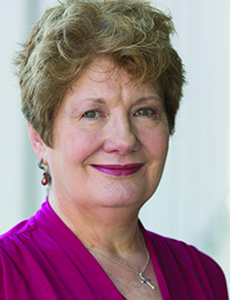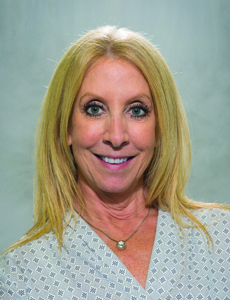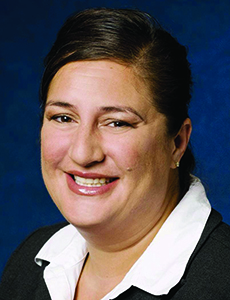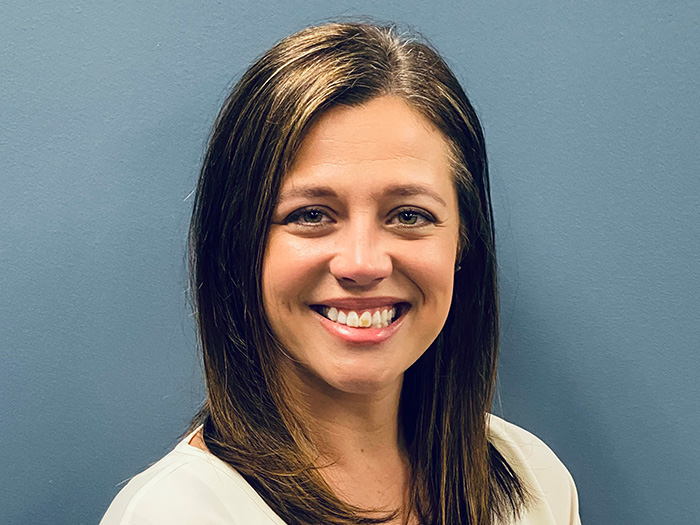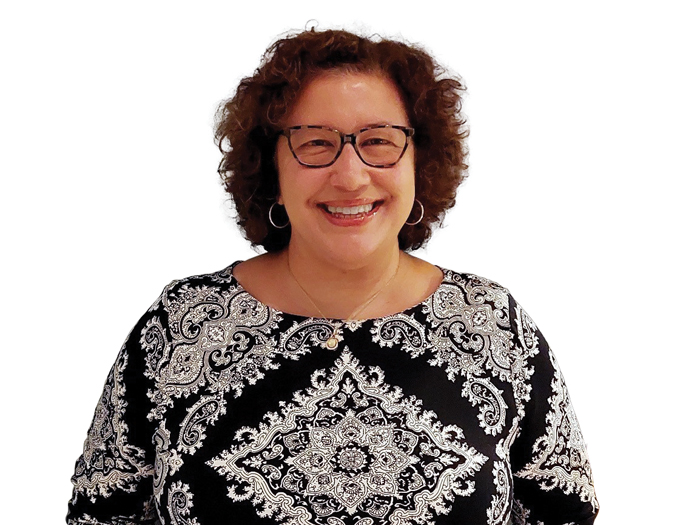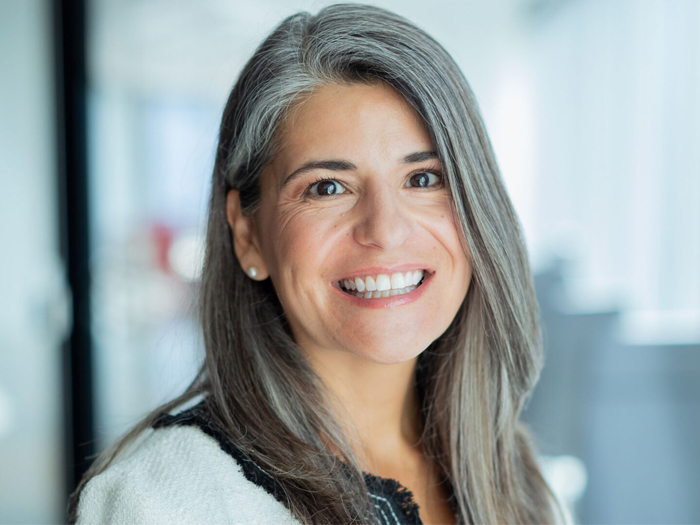2015 Teddy Awards
Commitment to Care
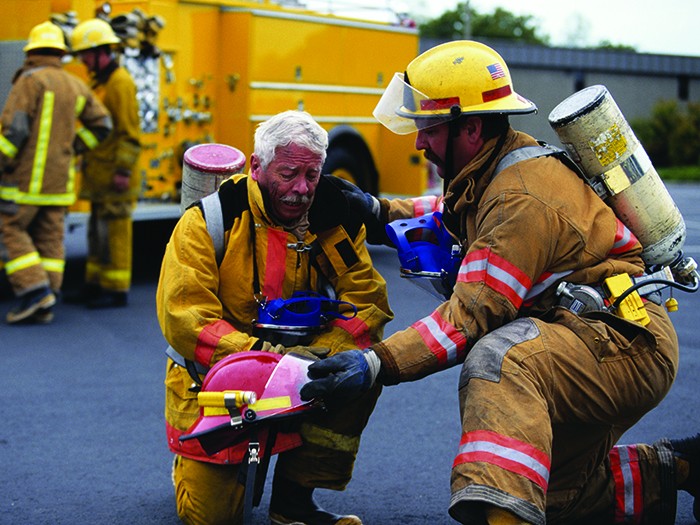
The worlds of workers’ comp and claims management grow more complex almost by the day. A workers’ comp program that used to be managed in-house by a handful of people now involves a far broader field of expertise, with a small army of specialty partners, each armed with terabytes of data.
For the past 20 years, Risk & Insurance® has given the Theodore Roosevelt Workers’ Compensation and Disability Management Award to exceptional programs that innovate to produce the best results.
But even the leaders of those top-notch programs of decades past would likely be bewildered trying to navigate the ins and outs of managing today’s workplace illness and injury challenges.
The above factors are what made judging the winners of this year’s Teddy Award, sponsored by Sedgwick, so challenging and educational.
It was interesting to see that in addition to relying on advanced tools and strategies, the people leading top programs across the country have an old-fashioned streak. They aren’t just sitting behind desks and directing their teams by email or conference calls.
They’re out in the field, putting eyes on the situation, getting face-to-face with those with boots on the ground, and making things happen. They’re forging the kind of personal relationships necessary to drive meaningful progress.
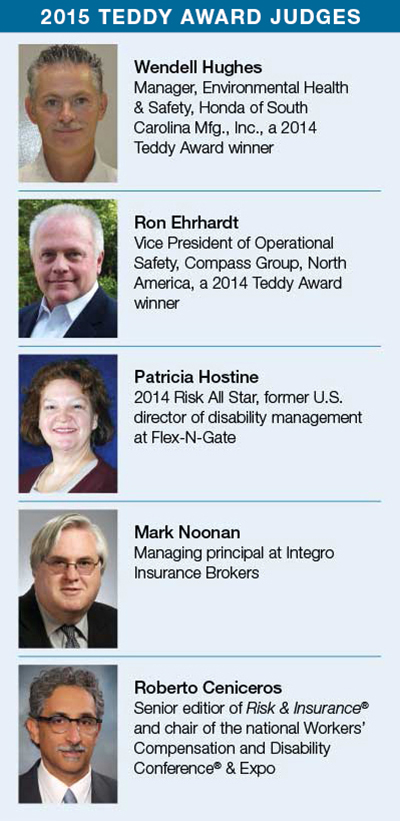 They also have a deep understanding of the fact that it doesn’t matter how you crunch the data, doing what’s right for injured employees will always be what’s right for the company.
They also have a deep understanding of the fact that it doesn’t matter how you crunch the data, doing what’s right for injured employees will always be what’s right for the company.
Without exception, every Teddy Award application we received gave us something to applaud. It’s never easy to isolate which ones to introduce to readers as Teddy Award winners. To help with the task, we enlisted the help of a panel of experts with decades of experience.
This year’s panel included Ron Ehrhardt, vice president of operational safety, Compass Group, a 2014 Teddy Award winner; Wendell Hughes, environmental, health and safety manager, Honda of South Carolina, a 2014 Teddy Award winner; 2014 Risk All Star Patricia Hostine, former U.S. director of disability management at Flex-N-Gate; Mark Noonan, managing principal at Integro Insurance Brokers; and Roberto Ceniceros, senior editor of Risk & Insurance® and co-chair of the National Workers’ Compensation and Disability Conference® & Expo.
Judges reviewed Teddy applications independently, and then gathered via conference call to share their thoughts and opinions. They then rated each finalist numerically in five separate categories. The overall average ratings determined the winners.
Results are typically the easiest place to start. Injury frequency, lost time, and medical and indemnity cost data is carefully evaluated with an eye toward year-over-year improvement in performance. Judges considered mergers, fluctuations in staffing levels and other factors that may have influenced outcomes.
But numbers are just one piece of the puzzle. Program longevity is also evaluated. Most new programs produce impressive numbers in the early years, when low-hanging fruit is easiest to pick. However, a longstanding program showing modest, steady gains year after year may be equally impressive.
Hazard levels and complexity are considered as well — health care facilities, for instance, face a dramatically different set of risk exposures than supermarkets.
Top programs exemplify an absolute commitment to bringing injured employees back to work, keeping them at work, and accommodating virtually any kind of restriction, by any means necessary.
Judges evaluate the finalists based on their own knowledge and experience of what works and what doesn’t, with an eye toward selecting programs that are not only successful today, but have the tools in place to remain successful for the long haul. Flexible, sustainable programs have the infrastructure in place that can adapt over time as the company grows and evolves.
Up Close and Personal
A common thread among this year’s Teddy Award candidates was that top workers’ comp professionals don’t shy away from getting in the thick of things. Anne-Marie Amiel, risk manager for 2015 Teddy Award winner Columbus Consolidated Government, received reports that there had been multiple trips and falls in the city’s Fleet Yard body shop. So she went to inspect the shop herself. Spotting a raised lip on a step going into the shop, she asked that the raised edge be painted a bright cautionary color. Result: no more tripping incidents.
She also visits with all of the medical providers who treat injured city workers, to put a “face” on the city so providers know who to call if they have a question about an employee or light-duty options.
Similarly, management at Teddy Award finalist SEEK, a staffing agency based in Grafton, Wis., does onsite visits with clients and conducts safety walkthroughs to get a first-hand look at any location into which they might be sending employees.
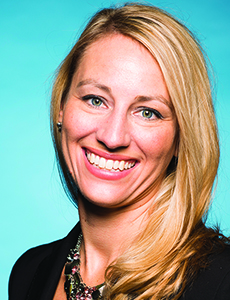
Jennifer Saddy, director of workers’ compensation, director of corporate insurance and risk management, American Airlines
2015 Teddy Award winner American Airlines’ workers’ compensation director Jennifer Saddy and her team also meet face-to-face with clinical personnel to discuss expectations and parameters. They conduct in-person training sessions for their TPAs, medical providers, physical therapists and case managers to ensure that everyone involved has a complete understanding of the environment that airline employees work in and the risks they face.
Bringing Them Back
Only a decade ago, the return-to-work programs of many Teddy Award applicants could have been summed up as, “We bring employees back to work as soon as a doctor clears them to return to their jobs.” Some tried to accommodate limits like lifting restrictions. But the overall picture was typically basic.
In 2015, however, return-to-work is the arena where most Teddy Award applicants and winners shine brightest. Top programs exemplify an absolute commitment to bringing injured employees back to work safely, keeping them at work and accommodating virtually any kind of restriction, by any means necessary.
A number of Teddy Award applicants took a proactive approach to secure alternative funding to pay workers on modified duty to ensure there are no RTW obstacles.
They also eschew the past trend of using “busywork” for light-duty jobs, and seek out ways that recovering employees can make meaningful and productive contributions to their workplaces.
In the City of Sunnyvale, Calif., police and firefighters — the source of most of the city’s injury claims — are fully cross-trained. That doubles the field of potential modified-duty positions for both groups. An injured police officer, for instance, could easily be employed training new firefighters.
At Columbus Consolidated Government, a police officer with a knee injury was tasked with unravelling a database problem that resulted in unbilled trash collection. She was able to heal from her injury and help the city recoup $100,000 at the same time.
At Brookdale Senior Living, recovering workers engage in anything from planning holiday parties to reorganizing linen closets, to putting together sales and marketing packets — all tasks that need doing, but are a struggle for other workers to fit into their packed workdays.
At staffing agency SEEK, finding modified duty at client locations can be particularly challenging. SEEK uses the opportunity to offer injured workers training that will upgrade their skills or even teach them new skills that can broaden their placement opportunities.
“While our employees are assigned to light duty, we use the opportunity to better our product — the employee,” wrote Lynne Kossow, SEEK’s health and safety administrator.
For some companies, budgetary concerns make even simple RTW accommodations a difficult choice.
And there is the perennial struggle of how to pay the salaries of those on modified duty while at the same time possibly needing extra manpower to help with whatever tasks the injured worker is unable to do.
We noticed that a number of Teddy Award applicants are taking a proactive approach to securing funding for these concerns, and ensuring that there aren’t any obstacles preventing employees from getting back to work.
The State of Montana, for one, negotiated a program with its insurer that allows it to earn back a certain percentage of its annual premium. Those funds are then earmarked for making accommodations, restructuring work environments, redesigning workstations, and any of the other incidental costs of returning injured workers to the job.
The best part is that with the money saved by enabling more effective RTW, the state is gaining even more return on the premium it earns back.
2015 Teddy Award winner Barnabas Health, a hospital system facing departmental reluctance to place workers on modified duty due to payroll budget issues, carved out a line item in the HR budget to cover injured workers’ salaries during transitional work.
Brookdale Senior Living took a similar approach, allocating a special budget to pay workers on modified duty so it would not negatively impact the budget of individual communities. They chose to spin the arrangement as the company providing a “free” worker the community would have to help them. “WOW … did the attitudes change!” the company noted in its application.
Employees First
While there is still little collaboration between workers’ comp and group health at most companies, we saw evidence that some lines can blur, particularly when there is an obvious benefit to employees’ well-being and overall safety.
2015 Teddy Award winner Stater Bros. Markets instituted something it calls the ICE PACK program, which puts physical therapists on-site to offer free advice, taping, wrapping and icing for any aches, pains or injuries, whether the problems are industrial or non-industrial in origin. The program made an impact on overall employee health and resulted in fewer minor injuries becoming workers’ comp claims.
Stamford, Ct.-based Pitney Bowes manages an impressive array of employee programs and services that benefit those with either occupational or non-occupational injuries or illnesses. These programs are designed to help employees manage the many struggles that can arise in the course of an injury or disability.
“Pitney Bowes recognizes the connection between mental and physical health, and when evaluating any illness or injury, psychosocial, medical, psychological, economic and vocational considerations are explored and addressed as needed. This enables us to identify potential barriers to wellness, and our ability to remove those barriers to increase a timely, safe and successful return to work,” the company explained in its application.
_______________________________________________________
Read more about all of the 2015 Teddy Award winners:
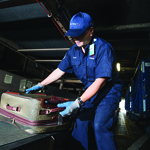 Revamped Program Takes Flight: The American Airlines and U.S. Airways merger meant integrating workers’ compensation programs for a massive workforce. The results are stellar.
Revamped Program Takes Flight: The American Airlines and U.S. Airways merger meant integrating workers’ compensation programs for a massive workforce. The results are stellar.
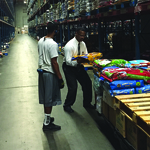 Checking Out Solutions: From celebrating safety success to aggressively rooting out fraud and abuse, Stater Bros. Markets is making workers’ comp risk management gains on multiple fronts.
Checking Out Solutions: From celebrating safety success to aggressively rooting out fraud and abuse, Stater Bros. Markets is making workers’ comp risk management gains on multiple fronts.
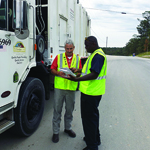 Revitalizing the Program: In three years, the Columbus Consolidated Government was able to substantially reduce workers’ compensation claims costs, revamp return-to-work and enhance safety training.
Revitalizing the Program: In three years, the Columbus Consolidated Government was able to substantially reduce workers’ compensation claims costs, revamp return-to-work and enhance safety training.
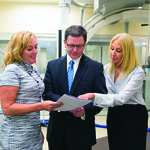 Spreading Success: Barnabas Health wins a Teddy Award for pushing one hospital’s success in workers’ comp systemwide.
Spreading Success: Barnabas Health wins a Teddy Award for pushing one hospital’s success in workers’ comp systemwide.

